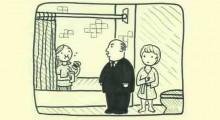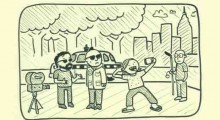Line Items
-
15 Sexy Things You Get to Do When You Think Your Film is Finished

Okay, you’ve spent seven years making your indie opus, another two years playing the festival circuit, and somewhere along the way you even managed to sell your film and get distribution. Hooray, you’re done and the party’s over! Your goal by this point is undoubtedly to move on and start working on the next film. But, wait a second, just because you’ve “sold” your film and you “got” distribution doesn’t mean your job as a filmmaker is “done” (or that you need to stop using “air quotes”). On the contrary, you’re still staring at a 20-to-life sentence for your film. […]
-
The Seven Arts of Working in Film: A Necessary Guide to On-Set Protocol

Welcome to your first day on a film set. Perhaps you’ve gotten a new job as a production assistant. Perhaps you’re still in school and have been given an opportunity as an intern, or you’ve recently been asked to help out with a friend’s production. You probably have some questions. I’m writing this because I’d like to try to answer some of those questions in advance, and because I have hope. Hope that maybe the next time I ask someone to sweep up some glass that just broke, I won’t have to explain where to get a broom, how to […]
-
What Everyone Does on a Film Set

For those new to physical production, here is a list of film set departments, with notes on their staff positions, responsibilities, benefits and attractions. PRODUCTION Personnel: Production Manager, Production Coordinator, Office PAs, Assistants to Directors and Producers. Responsibilities: Organization, preparation, taking care of actors, producers and director. Join this department if you like: Working on a movie without being chained to a set, knowing everything that’s going on, fielding constant complaints. Favorite Game: Choosing a new person to hate every day. ASSISTANT DIRECTOR DEPARTMENT Personnel: 1st AD, 2nd AD, 2nd 2nd AD, Key PA, On Set Interns. Responsibilities: […]
-
Let’s Kill the Web Series

Recently I conducted a nonscientific survey among friends. I asked, “What do you think when I say ‘Web series?’” The response was overwhelmingly negative. From a Hollywood agent friend, I heard, “Waste of time and money.” From a television writer, I heard, “Someone asking me to help crowdfund their reel.” But the most damning response came from a friend outside of the new media/film/TV industry. Their response was simply “Ugh.” As someone who has made a career making Web series and online videos, that’s disheartening, to say the least. You could have the most brilliant concept for a Web series, […]
-
23 Fragments on the Future of Cinema

Asked to address the question of the moment, James Schamus responds with this provocative, exhilarating meditation on cinema, its death, and the possibilities of its non-future. A speech given November 18, 2014 at the German Film Academy. 1. Let us begin with a quotation, from the late, great Theodor Adorno: “Whoever speaks of culture speaks of administration, whether this is his intention or not.” 2. You have invited me here tonight to speak on the topic of “The Future of Cinema.” This is not an easy task, given all the challenges buffeting our industry and our art form, challenges such […]
-
How to Find a Producer for Your Independent Film

“How do I find a producer?” It’s a question asked by many first-time independent writer/directors, and there’s good reason this seemingly simple query is so vexing. Screenwriters selling commercial screenplays and directors seeking employment on Hollywood pictures are guided by standard, usually market-based protocols. But it’s not so easy for budding independent auteurs — those without agents, managers or box-office track records. For them, partnering with a producer is as much about building a personal relationship as scoring a business transaction. At least, that’s what a number of producers interviewed here likened it to. Mary Jane Skalski (Very Good Girls, […]
-
Filmmaking in Pairs: The Benefits of Directing Movies with Another Person (or Other People)

Filmmakers don’t get to be moody loners. If you’re a painter or a writer, you have the option to go it alone. Sit in your room, bang out that first draft. Or, lock the door, stretch the canvas and go to it. Film is different: It’s rarely a solo pursuit, especially at the feature level. As filmmakers, we’re forced out of isolation and compelled to rely on others: producers, editors, sound people, lawyers, distributors. We’re team players, whether we like it or not. Paradoxically, though, at the end of the day we have an “auteur-biased” rewards system. With many films […]
-
Graphic Design: Jon Reiss and Joaquin Baldwin on Bomb It 2

Director Jon Reiss’s sequel to the street art doc Bomb It, Bomb It 2 finds innovative graffiti styles all across the globe, from cities like Tel Aviv to Jakarta. The film’s graphics playfully underscore the themes of the film while orienting viewers to its geography. Jon Reiss, director: We wanted to give a sense of the global scope and far-flung cities that we visited, while also taking Shepard Fairey’s amazing iconic Bomb It image and having it come to life. So I came up with the idea of old-school planes flying around the globe and targeting the cities we went […]
-
The Limits of Quality Control: On Sticking with Mini-DV

There are many reasons why people get into making movies, but the fetishizing of gadgets might be my least favorite. Cheaper, higher-end video cameras make “quality” more attainable, but no matter how many pixels there might be in a high-definition image, it can’t make a story clearer. Yet, independent filmmakers are often drawn to the newest, hottest equipment, as if the barrier to making a decent movie can be scaled by stacking the latest and fanciest gear and climbing over. I’ve made four nonfiction features and, like a digital video Luddite, I’ve shot all of them with my trusty Panasonic […]
-
Not an Option: The Ins and Outs of Shopping Agreements

The motion picture and television industries have become increasingly informal in recent years. In the past, agents would sign actors and writers before trying to sell their services or material, members of producing teams would sign collaboration agreements with their partners before taking a project to a studio, and producers would enter into written option agreements with writers under which they would pay money to exclusively option the motion picture and television rights to a property. These days, however, many agents will “hip-pocket” new artists and promote them without a contract to avoid commitment; a collaborator will walk a project […]
